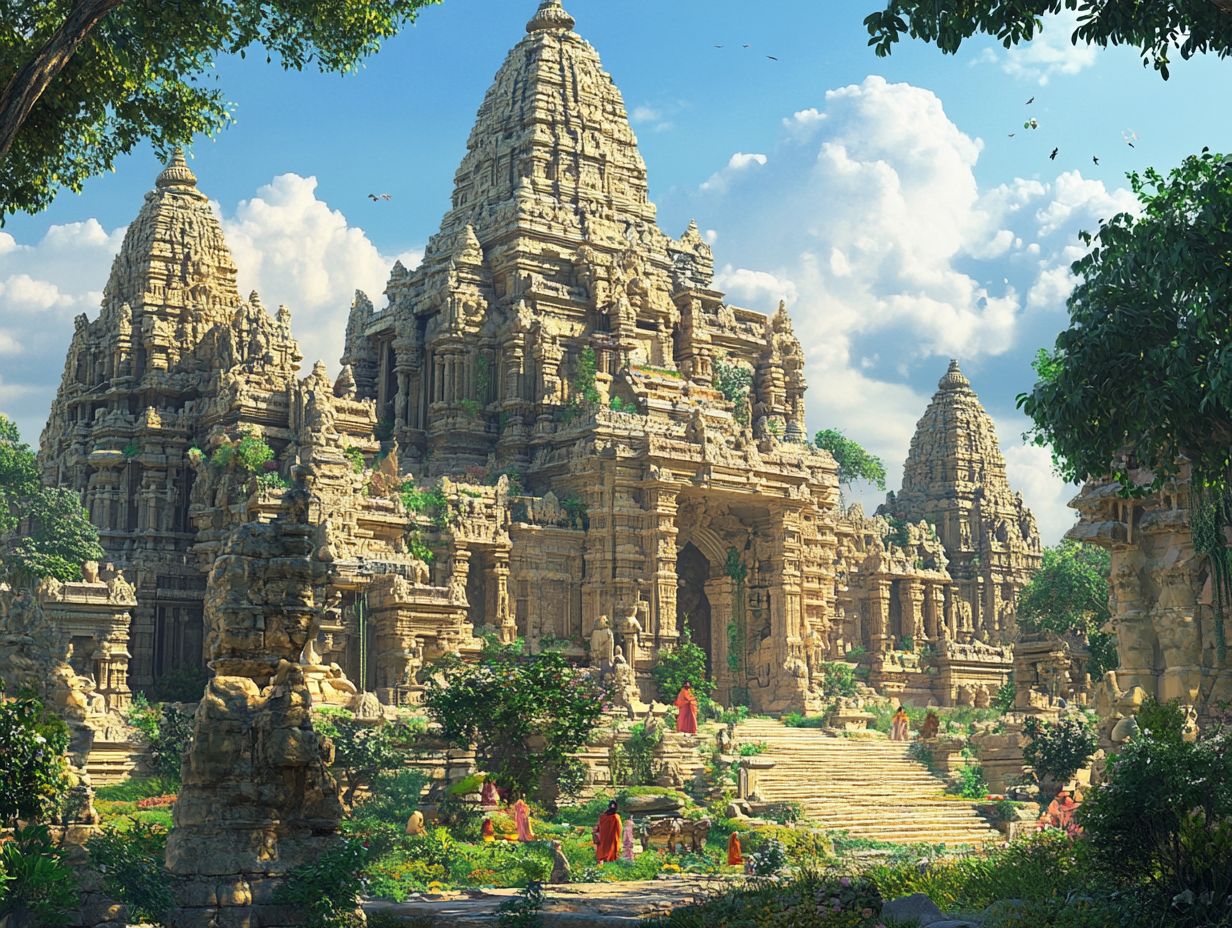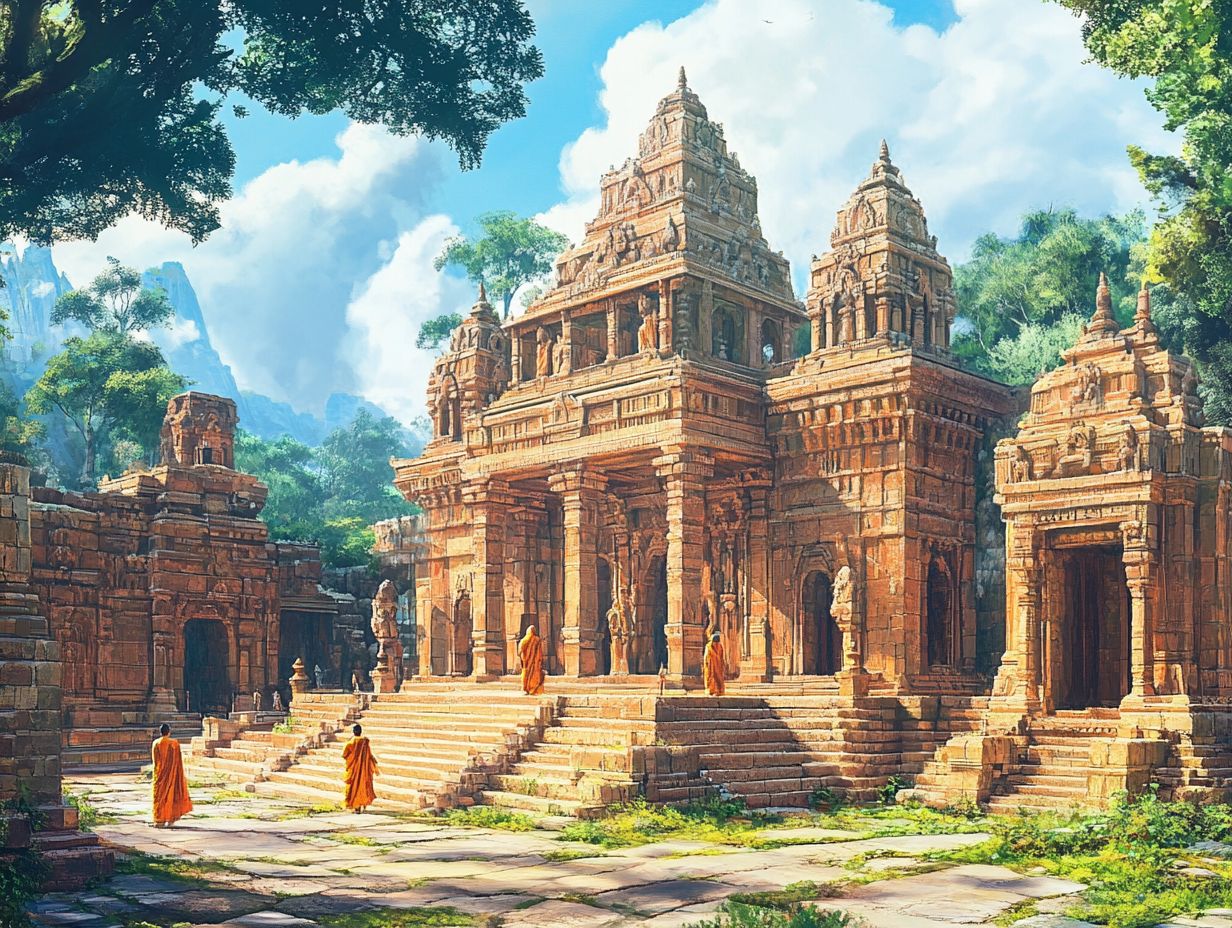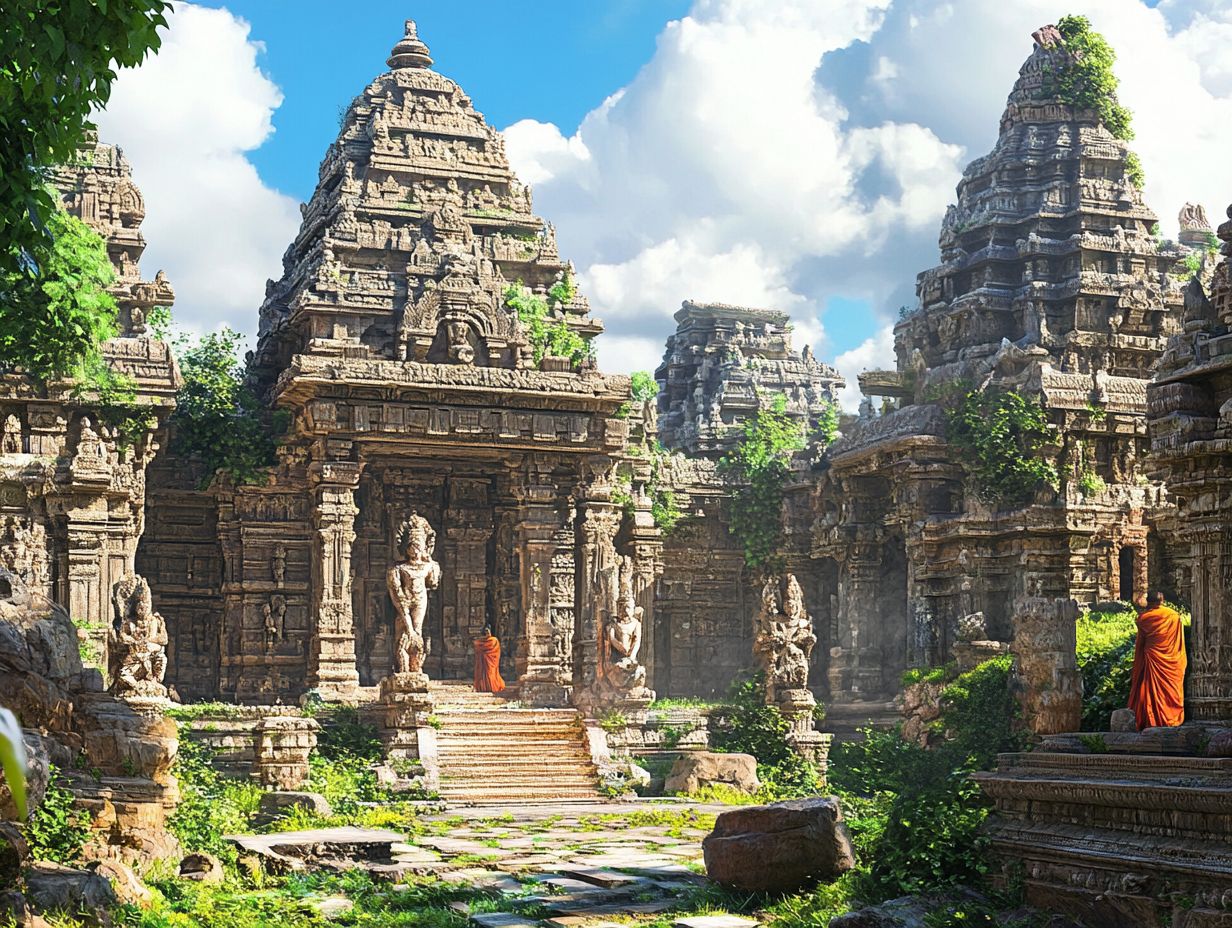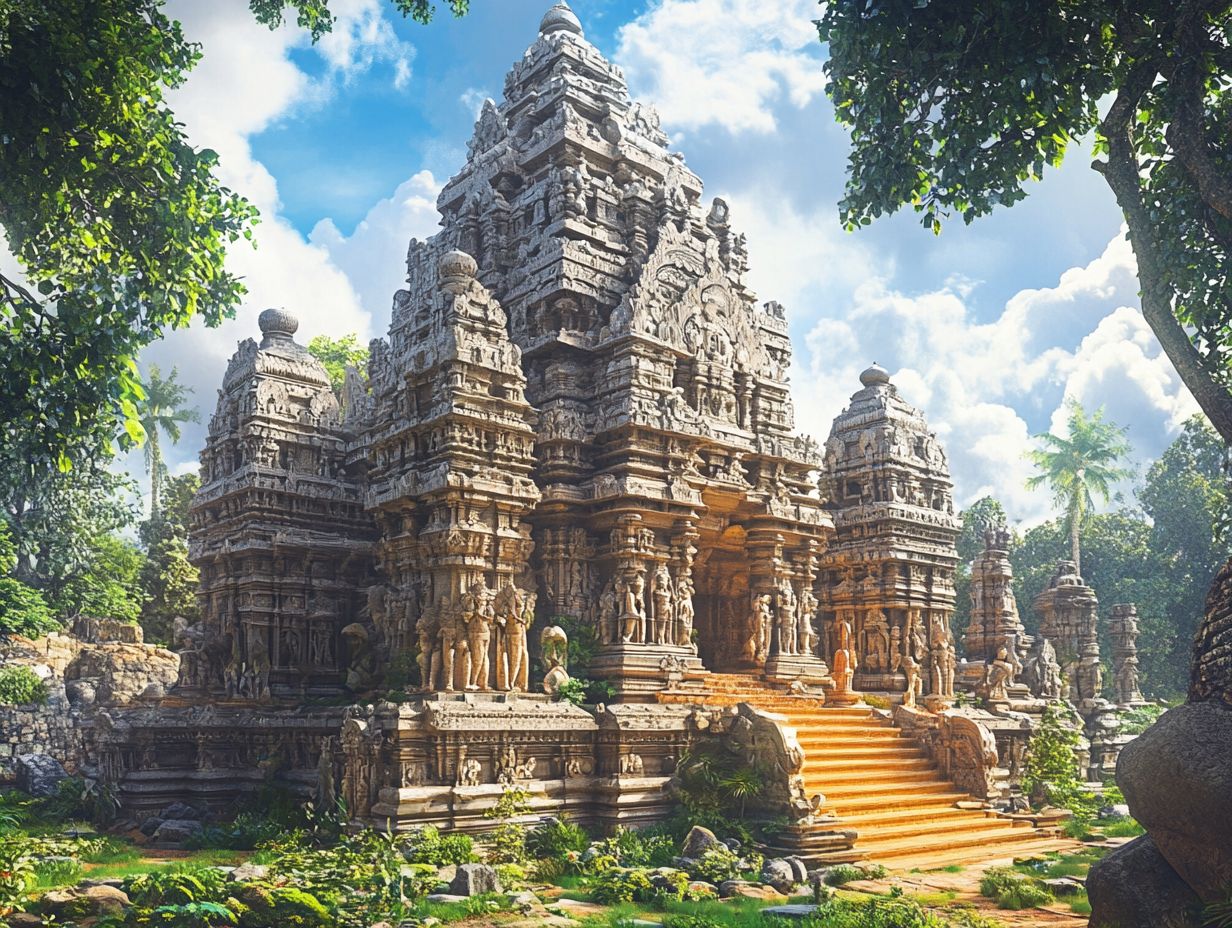Under Which Dynasty Was Hinduism Most Widely Practiced?
Hinduism, recognized as one of the world s oldest religions, possesses a rich and intricate history that spans millennia. This exploration delves into its evolution, tracing its roots from the pre-Vedic period through various notable dynasties, including the Mauryan, Gupta, Chola, and Mughal Empires.
It highlights the ways in which political, social, and economic factors have influenced the spread and practice of this ancient faith, as well as its diverse rituals and religious practices.
The profound impact of Hinduism on Indian society and culture, as well as its contemporary status both within India and across the globe, is also thoughtfully examined.
This journey invites one to uncover the fascinating narrative of this remarkable tradition, revealing the depth and complexity that has shaped its enduring legacy and cultural influence.
History of Hinduism

The history of Hinduism presents a rich tapestry of beliefs, practices, and philosophies that have undergone significant evolution over millennia in ancient India. It traces its roots back to the Vedic period, marked by foundational texts such as the Vedas and Upanishads, which form the core of Hindu scriptures.
This intricate religion has absorbed a diverse array of cultural practices and spiritual beliefs, often intertwining with other faiths like Buddhism and Jainism. As a result, it has fostered a unique synthesis of traditions and philosophies that continue to influence the social order and ethical perspectives within the Indian subcontinent.
Pre-Vedic Period
The Pre-Vedic Period of Hinduism is marked by indigenous beliefs and spiritual practices that took root in the early agrarian societies of ancient India. During this era, rituals and community worship were vital components of social life and cultural identity.
In this context, various tribal groups cultivated their own distinct spiritual traditions, emphasizing a profound connection with nature, ancestors, and the rhythms of life. These early communities engaged in rituals that not only honored their deities but also fostered unity among members through shared experiences and collective celebrations.
Spiritual leaders emerged as pivotal figures within these societies, guiding individuals through significant rites of passage and nurturing a sense of belonging. Over time, these indigenous practices formed the essential bedrock for the more structured religious frameworks that would evolve in subsequent periods, illustrating the ongoing development of spiritual thought and traditional knowledge in the region.
Vedic Period
The Vedic Period represents a transformative epoch in Hinduism, distinguished by the composition of the Vedas. These foundational scriptures encapsulated rituals, hymns, and philosophical discourse, profoundly shaping the religious landscape of ancient India.
This era not only established the bedrock for diverse religious practices but also acted as a catalyst for the emergence of Brahmanism, a spiritual system intricately connected to the societal hierarchy. Central to this framework were rituals such as yajnas, which underscored the importance of the priestly class and their pivotal role in mediating the interactions between humanity and the divine.
As time progressed, these sacred texts enabled the rise of various philosophical schools, each offering unique interpretations of concepts such as dharma, karma, and moksha. This confluence of ideas forged a complex ethical framework that continues to resonate in contemporary thought. The interplay of ritualistic worship with philosophical inquiry highlighted a balanced pursuit of spiritual understanding and societal order, blending rituals and philosophy seamlessly.
Post-Vedic Period
The Post-Vedic Period marked a significant evolution within Hinduism, characterized by the emergence of various sects and movements, alongside the rise of Buddhism and Jainism. This era facilitated a vibrant cultural synthesis that profoundly influenced social practices and spiritual beliefs throughout ancient India.
During this transformative time, religious pluralism thrived, enabling a diverse array of philosophies and rituals to coexist, thus shaping the spiritual landscape of the period. As Buddhism and Jainism introduced innovative ethical frameworks and meditative practices, Hinduism began to adapt, integrating these elements and fostering rich dialogues among the diverse traditions.
The rise of devotional movements, particularly Bhakti, highlighted a shift towards personal devotion to deities, effectively challenging rigid caste norms and democratizing spirituality. Additionally, the incursions of foreign invaders brought forth new ideas and cultural influences, further enriching the existing framework of Hindu practices.
This illustrates how Hinduism has continually evolved while steadfastly maintaining its deep-rooted cultural heritage and historical significance.
Most Widely Practiced Under Which Dynasty?
Hinduism flourished through the ages, nurtured by a succession of dynasties in ancient India, each leaving an indelible mark on its practices and philosophies.
Notably, during the Maurya and Gupta dynasties, a vibrant tapestry of art, literature, and temple architecture emerged, showcasing the significant impact of religious patronage on the cultural milieu of the time.
Mauryan Dynasty
The Mauryan Dynasty, particularly during the reign of Ashoka, is renowned for its advocacy of religious tolerance and the harmonious integration of Hinduism with Buddhism. This era witnessed a remarkable cultural synthesis that left a lasting impact on the religious practices of the time.
Under Ashoka’s leadership, a profound transformation occurred as he embraced non-violence and endeavored to unify various religious beliefs through a framework of mutual respect. His edicts, meticulously inscribed on pillars and rocks throughout his vast empire, not only championed ethical governance but also emphasized the preservation of sacred texts, thereby safeguarding the rich literary heritage of Hinduism.
This innovative blend of beliefs fostered an environment in which diverse religious practices coexisted harmoniously, shaping social hierarchies and influencing political structures. Consequently, Hinduism was enriched, becoming more inclusive and laying the groundwork for its enduring significance within the cultural landscape of India, and influencing the development of its religious texts.
Gupta Dynasty

The Gupta Dynasty is often hailed as the Golden Age of Hinduism, a remarkable period characterized by an extraordinary flourishing of temple architecture, arts, and philosophical inquiry that entrenched Hindu cultural practices across ancient India.
During this era, magnificent temples emerged, adorned with intricate sculptures and exquisite carvings that depicted a pantheon of deities, thereby underscoring the profound influence of the divine in the everyday lives of the people. These architectural masterpieces transcended mere places of worship; they became vibrant centers for community gatherings and celebrations, reinforcing the ethical and moral values central to Hindu teachings.
Plus the architectural renaissance, this period also produced remarkable literary works. Scholars and poets crafted texts that delved into the complexities of human experience and the intricacies of divine connection. Philosophical schools thrived, igniting spirited debates on virtue, duty, and the nature of reality contributions that significantly enriched the collective understanding of Dharma among the populace. The Gupta period also saw advancements in yoga and meditation practices, further deepening spiritualism.
Chola Dynasty
The Chola Dynasty played a pivotal role in the advancement of Hinduism, primarily through its remarkable temple architecture, which functioned as vital centers for communal worship and rituals, thus enriching the cultural and religious landscape of ancient India.
These splendid edifices, exemplified by the Brihadeeswarar Temple in Thanjavur, transcended their primary function as places of worship to become significant pilgrimage destinations, drawing devotees from distant regions. The intricate sculptures and meticulously crafted inscriptions adorning these temples vividly portrayed the narratives of Hindu deities, facilitating a deeper appreciation and understanding of the faith.
During the Chola period, regional variations in worship practices flourished, allowing for a diverse array of rituals and festive gatherings within these sacred spaces. This diversity not only fostered stronger community bonds but also promoted cultural exchange. Temples evolved into vibrant social hubs where art, music, and dance thrived, thereby enriching both the spiritual and communal life of the populace. The Cholas also contributed significantly to the preservation and propagation of Hindu scriptures written in Sanskrit, further emphasizing their devotion to the faith.
Vijayanagara Empire
The Vijayanagara Empire significantly contributed to the revival and flourishing of Hinduism by providing extensive patronage to the arts and fostering a cultural synthesis that harmonized various sects and traditions within the religion.
During this vibrant era, magnificent temples were constructed, adorned with intricate carvings that vividly depicted mythological scenes. These temples served not only as places of worship but also as cultural hubs for the community, becoming focal points for social interaction and spiritual engagement. The empire’s support for religious diversity and inclusivity helped Hinduism to flourish in a way that embraced a wide array of devotional movements and practices.
The empire actively promoted the celebration of festivals, reinforcing social bonds and rituals that were integral to daily life. By incorporating elements from other religions, it facilitated a unique cultural dialogue that enriched the spiritual landscape, making Hindu practices more inclusive and accessible. This cultural exchange also highlighted Hinduism’s enduring philosophy and its extensive use of Sanskrit in Vedic texts.
This melding of traditions fostered a sense of unity among diverse communities, ultimately establishing a legacy that significantly shaped the social fabric and social structure of the region for generations to come. This period also saw the flourishing of art, architecture, and the erection of temples dedicated to various deities.
Mughal Empire
During the Mughal Empire, Hinduism entered a remarkable phase characterized by religious tolerance and cultural exchange, fostering a syncretic relationship with Islamic traditions that gave rise to new philosophical ideas and practices within the faith. This period was significant in the historical timeline of Hinduism, showcasing the synthesis of religious practices and philosophical thought.
This era represented a profound transformation, particularly under the reign of notable Mughal rulers like Akbar, who implemented policies that advocated for dialogue among diverse religious communities. Akbar’s policies were instrumental in promoting religious syncretism and inclusivity, which were key elements of his administration.
Such openness enabled Hindu scholars to engage in meaningful discussions with their Islamic counterparts, creating an environment where ideas flourished beyond the confines of sectarianism.
Artistic collaborations thrived during this time, yielding unique expressions that seamlessly blended motifs and themes from both traditions. This interplay not only enriched the cultural landscape but also nurtured syncretic practices such as the Bhakti movement, which emphasized personal devotion and played a pivotal role in redefining spiritual experiences. The period also saw the influence of various gurus and saints who propagated these ideas.
Ultimately, this historical context highlights the enduring legacy of inter-religious harmony that continues to shape contemporary dialogues.
British Raj
The British Raj ushered in profound transformations within Hinduism, sparking the emergence of reform movements aimed at addressing social issues and adapting Hindu practices to the complexities introduced by colonial rule.
During this dynamic period, influential leaders and thinkers rose to prominence, advocating for reforms that sought to modernize the faith while honoring its rich traditions. This period also saw the reinterpretation of Hindu scriptures and an emphasis on social justice and gender equality.
Shaped by Western education and ideals, these movements illuminated the pressing need for social justice, gender equality, and a reinterpretation of ancient texts to align with contemporary realities.
As Hindu communities navigated the intricacies of British governance, they began to underscore the significance of a collective identity and social order. These shifts were evident in the re-evaluation of rituals and practices to better align with Western education and ideals.
This shift ultimately provided a foundation for a revitalized sense of spirituality that resonated with modern practices. The challenges presented by colonialism not only served as a catalyst for these reforms but also sparked a deeper engagement with the evolving landscape of Hindu thought and practice.
Factors Influencing the Spread of Hinduism
The proliferation of Hinduism has been shaped by a multitude of factors, encompassing political, social, and economic dynamics. Each of these elements has played a vital role in defining its practices and extending its influence across various regions. Historical records and archaeological findings provide insights into how these factors interacted over time.
Political Factors

Political factors have historically wielded considerable influence over the spread of Hinduism, with dynastic patronage and governance shaping religious practices and the construction of temples throughout various regions of ancient India. The influence of dynasties such as the Guptas, Mauryas, and Cholas was particularly notable in this regard.
Various rulers, by supporting Hindu institutions, not only reinforced the existing social hierarchy but also facilitated the dissemination of religious ideologies. The creation of elaborate temples became a manifestation of their devotion, serving as both places of worship and symbols of power that drew in pilgrims from far and wide.
Dynasties such as the Cholas and Guptas, for instance, perceived their legitimacy as intrinsically linked to the divine, prompting them to sponsor rituals and festivals that bolstered their authority. This intricate relationship between politics and religion not only solidified Hinduism’s roots within the cultural fabric but also illuminated how governance influenced societal norms and spiritual beliefs. These political dynamics were further reflected in the construction of architecture and the patronage of religious art.
Social Factors
Social factors, such as the caste system and community worship practices, have significantly shaped the evolution and dissemination of Hinduism, influencing its rituals, traditions, and the organization of religious life. The caste system and social hierarchy have historically governed access to religious knowledge and participation in religious activities.
These elements have not only established the social hierarchy within communities but have also dictated how individuals engage with their spiritual beliefs. These factors have contributed to the development and perpetuation of indigenous practices that are integral to Hinduism.
The caste system, in particular, has historically governed access to religious knowledge, participation in temple activities, and observance of festivals, making it a vital aspect of social life.
Communal practices further strengthen connections among devotees, fostering community bonds during significant rituals and celebrations. Consequently, festivals often serve dual purposes celebrating deities while reinforcing established social structures.
This intricate interplay between ritual and social dynamics exemplifies the profound impact that social factors have had on the ongoing journey of Hinduism.
Economic Factors
Economic factors have played a pivotal role in the proliferation of Hinduism, with trade routes facilitating pilgrimages and the establishment of temples that function not only as religious sites but also as economic hubs.
These temples often emerged as central points for local commerce, where merchants and artisans congregated, creating vibrant marketplaces that drew visitors from diverse regions. The integration of economic and religious activities exemplified the sacred geography of Hinduism.
As individuals traveled along these trade routes, they carried with them not only goods but also cultural practices and social structures, which contributed to the spread of Hindu beliefs. This movement facilitated the exchange of icons and symbolism that are central to Hindu worship.
Pilgrimages to sacred sites served to reinforce social order, as devotees engaged in communal activities that strengthened bonds within their communities. Through the seamless integration of religious and economic pursuits, Hinduism found fertile ground to flourish and adapt, becoming intricately woven into the social fabric of the regions it touched.
Impact of Hinduism on Indian Society and Culture
Hinduism has had a profound influence on Indian society and culture, intricately shaping its traditions, festivals, and ethical frameworks. This influence extends to the religious texts and epic literature like the Puranas which are essential to its cosmology and ethics.
This ancient belief system fosters a sense of community and social order that permeates various aspects of daily life, weaving a rich tapestry of shared values and practices that continue to resonate across generations.
Current Status of Hinduism
The current status of Hinduism presents a vibrant and dynamic religion, where contemporary practices seamlessly adapt to the evolving landscape of modern society. This adaptability is coupled with a robust global presence, marked by religious pluralism and a multitude of diverse interpretations that enrich the faith. Contemporary practices often integrate elements of yoga, meditation, and spiritualism into daily life.
Hinduism in India
In India, Hinduism persists as a prominent religion, embodying a rich tapestry of contemporary practices and regional variations that reflect the diverse experiences of its adherents and their festivals.
These practices often intertwine deeply with the cultural heritage of distinct communities, where rituals and ceremonies can differ markedly from one region to another. The diversity within these practices reflects the regional variations and local interpretations of Hindu scriptures.
Celebrations such as Diwali, Holi, and Navratri not only serve as profound expressions of devotion but also cultivate a sense of belonging among participants, reinforcing the bonds within the community. These festivals are rooted in the rich tapestry of ancient Indian traditions and rituals.
Local traditions and interpretations infuse these festivals with layers of meaning, rendering each celebration unique while remaining anchored in shared beliefs. The vibrancy of Hindu festivals stands as a testament to the enduring spirit of this faith, uniting individuals from various backgrounds in honoring their collective heritage.
Hinduism in the World

Hinduism has established a notable presence on a global scale, particularly among the Indian diaspora, where it continues to shape cultural practices and engage in meaningful inter-religious dialogue with various faiths.
This dynamic interaction fosters a rich exchange of ideas, cultivating a climate of religious pluralism that strengthens community ties. As individuals migrate, they bring along their traditions, festivals, and rituals, weaving a vibrant multicultural tapestry in their new locales. This movement has led to the spread of Hinduism’s beliefs and practices globally.
Within these diverse settings, Hindu communities actively engage in dialogues with other religions, focusing on shared values and mutual respect. This interaction reflects the enduring spirit of religious diversity and tolerance.
Participation in interfaith events, workshops, and cultural celebrations not only deepens their understanding of their own beliefs but also enhances appreciation for the richness of other faiths. Such interactions foster a sense of harmony and inclusivity.
Such initiatives serve to reinforce their identity while promoting unity and harmony within multicultural societies.
Frequently Asked Questions
Under Which Dynasty Was Hinduism Most Widely Practiced?
The Gupta dynasty, which ruled from 320-550 CE, was a golden age for Hinduism and saw the widespread practice and influence of the religion in ancient India. This period also witnessed the creation of numerous temples and the composition of important religious texts.
What time period did the Gupta dynasty rule?
The Gupta dynasty ruled from 320-550 CE, known as a golden age for Hinduism.
How did the Gupta dynasty contribute to the spread of Hinduism?
The Gupta rulers supported and patronized Hinduism, allowing for its growth and expansion throughout ancient India. Their patronage extended to the preservation and dissemination of scriptures and the promotion of rituals and ceremonies.
What cultural and intellectual achievements occurred during the Gupta dynasty in ancient India?
The Gupta dynasty is known for its cultural and intellectual achievements, including the widespread practice of Hinduism, advancements in literature, math, and science, and the construction of magnificent temples dedicated to Hindu deities. This era also saw significant contributions to the Vedic texts, philosophy, and the social structure of ancient India, marking a period of great cultural influence and rich religious practices.
Did the Gupta dynasty have any impact on Hindu religious texts?
Yes, the Gupta dynasty provided a platform for the preservation and development of Hindu religious texts like the Vedas, Upanishads, and Puranas, contributing to the continued practice and evolution of Hinduism. The period was also noteworthy for its religious diversity, rituals, and the promotion of yoga and meditation as integral aspects of spiritualism.
What is the significance of the Gupta dynasty in the history and development of Hinduism?
The Gupta dynasty marks a golden age for Hinduism, during which the religion spread and flourished, and many of its enduring cultural and intellectual achievements were made. It is considered a crucial period in the evolution of Hinduism, influencing the later medieval period and contributing to the historical timeline of India’s religious identity and cultural heritage.
